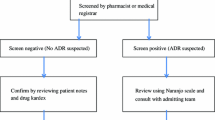Abstract
Aims To apply established methods to identify ADR-related admissions and to determine the proportion which was preventable and which were caused by non-prescription medicines (NPMs). Methods This prospective, observational study screened all acute hospital admissions (n = 1,101) by ward pharmacists over a 2-week period. Suspected ADR-related admissions were reported to the researcher and established criteria were used to evaluate probability, causality and preventability of the ADR-related admissions. Results Of the 1,101 emergency admissions which occurred during the study period, 30 were categorised as ADR-related, equating to a prevalence of 2.7% (95% CI, 1.8–3.7%). Three (9.7%) of the 30 admissions were associated with NPMs. The ADR was the dominant reason for admission in 56.7% (n = 17/30) and only 13.3% (n = 4/30) of all reported admissions were assessed as unavoidable. Conclusion The proportion of ADR-related admissions was lower than in previous studies in the UK. A substantial proportion of ADRs was associated with NPMs, highlighting the need for greater awareness amongst patients, prescribers and other health care professionals regarding possible serious adverse effects caused by these medicines.


Similar content being viewed by others
References
WHO. Safety of medicines – a guide to detecting and reporting adverse drug reactions. 2002.
Pirmohamed M, Breckenridge AM, Kitteringham NR, Park BK. Forthnightly review: adverse drug reactions. BMJ. 1998;316:1295–8.
Muehlberger N, Schneeweiss S, Harford J. Adverse drug reaction monitoring – cost and benefit considerations. Part 1: frequency of adverse drug reactions causing hospital admissions. Pharmacoepidemiol Drug Saf. 1997;6(3):S71–7.
Pirmohamed M, James S, Meakin S, Green C, Scott AK, Walley TJ, et al. Adverse drug reactions as cause of admission to hospital: prospective analysis of 18,820 patients. BMJ. 2004;329:15–9. doi:10.1136/bmj.329.7456.15.
Hitchen L. Adverse drug reactions result in 250,000 UK admissions per year. BMJ. 2006;332:1109. doi:10.1136/bmj.332.7550.1109.
Green CF, Mottram DR, Howe PH, Pirmohamed M. Adverse drug reactions as a cause of admission to an acute medical assessment unit: a pilot study. J Clin Pharm Ther. 2000;25:355–61. doi:10.1046/j.1365-2710.2000.00298.x.
Howard RL, Avery AJ, Howard PD, Partridge M. Investigation into the reasons for preventable drug related admissions to a medical admissions unit: observational study. Qual Saf Health Care. 2003;12:280–5. doi:10.1136/qhc.12.4.280.
Hussain RM. Case report: the sweet cake that reaches parts other cakes can’t!. Postgrad Med J. 2003;79:115–6. doi:10.1136/pmj.79.928.115.
Ferner RE, Aronson JK. National differences in publishing papers on adverse drug reactions. Br J Clin Pharmacol. 2005;59(1):108. doi:10.1111/j.1365-2125.2005.02267.x.
Waller P, Shaw M, Ho D, Shakir S, Ebrahim S. Hospital admissions for ‘drug-induced’ disorders in England: a study using the Hospital Episodes Statistics (HES) database. Br J Clin Pharmacol. 2005;59(2):213. doi:10.1111/j.1365-2125.2004.02236.x.
Williams D, Feely J. Underreporting of adverse drug reactions: attitudes of Irish doctors. Ir J Med Sci. 1999;168:257–61.
Naranjo CA, Busto U, Sellers EM, Sandor P, Ruiz I, Roberts EA, et al. A method for estimating the probability of adverse drug reactions. Clin Pharmacol Ther. 1981;30(2):239–45.
Rawlins MD, Thomas SHL. Mechanisms of adverse drug reactions. In: Davies DM, Ferner RE, de Glanville H, editors. Davies’s textbook of adverse drug reactions. 5th ed. Philadelphia: Lippincott-Raven Publishers; 1998. ISBN 0412824809.
Hallas J, Harvald B, Gram LF, Grodum E, Brosen K, Haghfelt T, et al. Drug related hospital admissions: the role of definitions and intensity of data collection and the preventability of prevention. J Intern Med. 1990;228:83–90.
Wilson EB. Probable inference, the law of succession, and statistical inference. J Am Stat Assoc. 1927;22:209–12. doi:10.2307/2276774.
Bhalla N, Duggan C, Dhillon S. The incidence and nature of drug-related admissions to hospital. Pharm J. 2003;270:583–6.
Ang-Lee MK, Moss J, Yuan C. Herbal medicines and perioperative care. JAMA. 2001;286(2):208–16. doi:10.1001/jama.286.2.208.
Carden SM, Good WV, Good RM. Case report – garlic and the strabismus surgeon. Clin Experiment Ophthalmol. 2002;30:303–4. doi:10.1046/j.1442-9071.2002.00540.x.
Committee on Safety of Medicines. Annual report (2002), NHS Scotland Edinburgh.
Teweleit S, Kuschel U, Hippius M, Goettler M, Bornschein B. Manifestation and possible prevention of adverse drug reactions (ADR) in pharmacotherapy of cardiovascular diseases. Med Klin. 2001;96(8):442–50. Manifestation and Praeventationsmoeglichkeiten unerwuenschter Arzneimittelwirkungen (UAW) in der Pharmakotherapie von Herz-Kreislauf-Erkrankungen. doi:10.1007/PL00002226.
Seymour RM, Routledge PA. Important drug-drug interactions in the elderly. Drugs Aging. 1998;12(6):485. doi:10.2165/00002512-199812060-00006.
Rozich JD, Haraden CR, Resar RK. Adverse drug event trigger tool: a practical methodology for measuring medication related harm. Qual Saf Health Care. 2003;12:194–200. doi:10.1136/qhc.12.3.194.
Acknowledgements
We thank the ward pharmacists at Aberdeen Royal Infirmary for screening the admissions as well as Shona Fielding and John Townend for their statistical support.
Funding
Yvonne Hopf was supported by the Clinical Pharmacology Programme Scholarship at University of Aberdeen.
Conflicts of interest
None.
Author information
Authors and Affiliations
Corresponding author
Appendix 1
Appendix 1
Screening form
Rights and permissions
About this article
Cite this article
Hopf, Y., Watson, M. & Williams, D. Adverse-drug-reaction related admissions to a hospital in Scotland. Pharm World Sci 30, 854–862 (2008). https://doi.org/10.1007/s11096-008-9240-5
Received:
Accepted:
Published:
Issue Date:
DOI: https://doi.org/10.1007/s11096-008-9240-5




